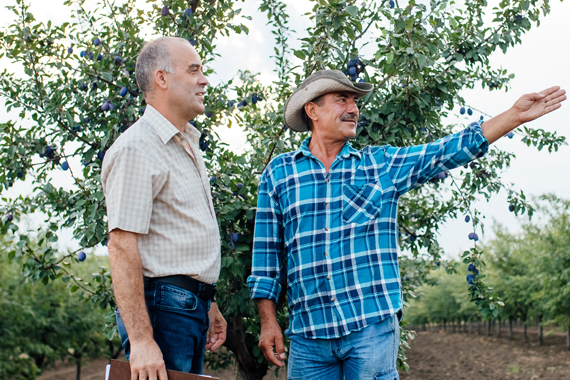
Tenancy right to buy finance from the very beginning. So you can learn and develop your understanding of agricultural finance.

Safety and stability comes with the certainty of ownership, and many farmers are seeking to purchase the land on which they farm. Tenant farmers who hold long-term leases over the land they work on may be entitled to register a “right to buy”, which enables them to submit an offer for the land in the event their landowner decides to sell it. This is often an extremely valuable option, and gives the farmer the security of knowing they won’t be left out in the cold if their landowner decides to sell up, but without the finances to back up a purchase it’s difficult for farmers to act on this right to buy.
By using bridging finance, it’s possible for farmers to quickly and confidently put funds in place to pay for the purchase of their land, and establish themselves as a landowner in their own right. Bridging finance is an ideal solution for many farmers because of it’s unique flexibility, and the speed with which it can be obtained; we’ll examine the ways in which bridging lenders enable farmers to complete purchases under a right to buy claim, and how it can be used to sustain long-term growth.
While bridging finance presents a powerful tool for farmers, it’s important to understand that a short-term secured loan is not a long-term solution. Bridging loans are designed to help put finances together quickly while a mortgage or long-term solution is sought, and as such are usually repaid as quickly as possible. As a form of secured finance, the lender is entitled to reclaim their money through repossession of the borrower’s assets, should they fail to repay, so farmers must consult an experienced financial advisor before committing to bridging finance, to ensure it’s the correct solution for their situation.
Many farmers are tenants of the land they work on, rather than outright owners, and while this is a workable long-term solution for many agricultural enterprises, becoming a landowner also comes with several benefits. Without the certainty of ownership, farmers are unable to control when the land is sold or who it’s sold to; they might find that their new landowner seeks to sell the land to property developers, for instance. In some situations, farmers are able to register a “right to buy” on their land, which means that if the landowner decides to sell it, the farmer gets first refusal. These claims must be renewed every 5 years, and if the land is made available for sale the farmer must register their interest within 28 days.
The ability to bid for their land is valuable, but without the finances to back it up this option is meaningless. Whilst the landowner must offer the farmer the option to purchase the land, there is no compulsion for them to offer this at anything under market value - an individual assessment is typically used, or else the two parties come to a mutual agreement on what constitutes a fair price. In either case, farmers will need to find a way of financing the purchase of their farmland, and they must turn to bridging finance in order to do so.
As with real estate, most land purchases are funded through a long-term financial solution such as a mortgage. These forms of finance generally enable landowners to gradually build up equity whilst keeping ongoing costs down, and are a suitable solution for long-term ownership. However, it can be difficult to obtain mortgages in a short space of time, and when the mortgage is for anything out of the ordinary (such as for farmland) it can be very difficult to quickly find a willing provider.
In these situations, bridging finance provides an ideal solution. Because bridging loans are flexible and fast to arrange, they may be put in place at short notice - many bridging lenders promise to take loans from application to approval in just a few days, with funds becoming available after only a week. Bridging lenders also take a much more holistic approach to lending, and assess a borrower not just on their credit history and proposed security, but on the merits of their individual projects. Many bridging lenders pride themselves on lending successfully where mainstream banks will not, and offer a highly specialised bespoke service to their clients.
The sheer flexibility of bridging finance makes it appropriate in many different situations, and the ability to secure these loans on many different types of asset allows farmers to leverage their existing property for the purposes of securing a loan. There are two forms of security available to farmers who wish to take out a bridging loan, and it is possible to combine them both to provide the necessary finances.
Most bridging loans are secured by a first charge on an asset or real estate. Typically this would be the property that the loan is being used to purchase, since the lender will be the primary source of finance; there will be no other lenders with claim to the asset. However, the asset being purchased may not always be suitable for securitisation, and may not constitute sufficient security in itself; in these situations, farmers must seek to provide additional security.
Providing first charge security requires the borrower to have no other finances in place on an asset. However, farmers will typically have substantial equity built up in their other assets such as a farmhouse or farm equipment. This equity can be securitised to help obtain a bridging loan, but because there is already a form of finance in place (such as a mortgage) the lender will only be able to take out a second charge security. This means they are second in line if they need to repossess the property, and can only reclaim their money once the initial lender has reclaimed theirs. Because it’s harder for them to make their money back, second charge loans typically cost more interest - however, farmers can leverage their existing assets to help them raise the necessary finance for a right to buy purchase, which can be an exceptionally valuable option.
A bridging loan is a short-term loan secured against property. It allows you or your business to “bridge a gap” until either longer-term finance can be arranged, or the underlying security or other assets can be sold.
Commercial bridging loans are, as their name implies, bridging loans that are secured against commercial property.
There are many ways in which businesses can use a commercial bridging loan. Common uses are to cover short-term cashflow issues or to finance tax liabilities. More positively they can be used as working capital and by new businesses as a cashflow injection to acquire additional stock or even to acquire new equipment or premises for the business. Beyond these examples there are a huge variety of ways in which commercial bridging loans can be used.
Yes. They can be a great tool for landlords who want to do renovations on their properties to improve rental yields. The value of the properties will also reflect these property improvements and make it easier for the landlord to refinance them onto competitive Buy-to-Let (BTL) mortgages and clear any bridging. Like residential bridging, commercial loans can also be useful when a property chain is broken.